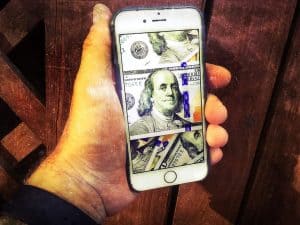 Mobile payments is one of the hottest sectors in Fintech.
Mobile payments is one of the hottest sectors in Fintech.
Venmo and Square/CashApp have battled for years over the hearts and minds of millennials, with CashApp recently declaring victory– thanks in part, some say, to its pioneering incorporation of Bitcoin trading into the app.
In May, Square CEO Jack Dorsey told an audience at the Consensus Conference in New York that many Square Cash App users are “underserved and even unbanked…(something the company wants to) lean into more.”
“What we’re seeing now is people are using it as their (primary) bank account,” said Dorsey, who added that the majority of Square Cash App payments are flowing in from Walmart, McDonalds and several other fast food outlets.
This fall, a study by the Global Financial Literacy Excellence Center at the George Washington School of Business also showed that users of mobile payment apps, though they tend to control more assets, also tend to be less financially literate and more impulsive than counterparts using traditional banking interfaces.
According to reporting at Quartz:
“A study of mobile-payment using millennials (ages 18-34) in the US found they were less likely to be financially literate than others of the same age who didn’t pay for things with their phones. They were also more likely to make other bad financial decisions, like overdrawing checking accounts, racking up credit card fees, borrowing from payday lenders, or dipping into their retirement accounts early.”
Mobile cash app users also make slightly more overdraws (25% versus 20%).
Researchers speculate that the ephemeral nature of telephone banking makes it easier to lose track.
”In the data we do not have information about what explains that behavior, but making payments easy and mindless may induce people to spend more,” Professor Annamaria Lusardi told Quartz in an email.
Point-of-sale mobile payments apps (such as Apple Pay and Google Pay) processed $70 billion in transactions in the US last year, and are expected to process $370 billion per year by 2022.
By then, users are expected to have gone from 50 million this year to 90 million. China, on the other hand, already has 500 million people using mobile wallets.
While the numbers for overdraws are close, mobile payment users show much worse financial behaviour than non-users in several other areas.
17% of mobile payment users reported they’d paid fees for going over their limits on credit cards, as opposed to 8% of non-users.
Only 9% of non-users said they’d withdrawn from their retirement accounts, as opposed to 37% of mobile payment users.
22% of mobile bank app users took out payday loans versus 9% of non-users.
Mobile banking users were also three times more likely to take out an auto-title loan (16% versus 5%).
Quartz proposes technical solutions to clue in people about the purchase decisions they make, including flashing lights and loud vibrations when a bad decision is about to occur.
But these are no substitute for financial education, says the outlet, which tends to promote good financial behaviour across groups.

